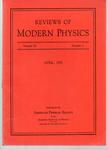版权所有:内蒙古大学图书馆 技术提供:维普资讯• 智图
内蒙古自治区呼和浩特市赛罕区大学西街235号 邮编: 010021

作者机构:Department of Mechanical Engineering University of Colorado Boulder Colorado 80309 USA and Materials Science and Engineering Program University of Colorado Boulder Colorado 80309 USA
出 版 物:《Reviews of Modern Physics》 (现代物理学评论)
年 卷 期:2018年第90卷第4期
页 面:041002-041002页
核心收录:
基 金:National Science Foundation, NSF, (0846561, 1512776) National Science Foundation, NSF Defense Advanced Research Projects Agency, DARPA National Natural Science Foundation of China, NSFC, (11425211) National Natural Science Foundation of China, NSFC Chinese Academy of Sciences, CAS
主 题:Phonons Two-dimensional electron system Thermal & statistical models
摘 要:Following the emergence of many novel two-dimensional (2D) materials beyond graphene, interest has grown in exploring implications for fundamental physics and practical applications ranging from electronics, photonics, and phononics to thermal management and energy storage. In this Colloquium, a summary and comparison are given of the phonon properties, such as phonon dispersion and relaxation time, of pristine 2D materials with single-layer graphene to understand the role of crystal structure and dimension on thermal conductivity. A comparison is made of the phonon properties, contrasting idealized 2D crystals, realistic 2D crystals, and 3D crystals, and synthesizing this to develop a physical picture of how the sample size of 2D materials affects their thermal conductivity. The effects of geometry such as the number of layers and the nanoribbon width, together with the presence of defects, mechanical strain, and substrate interactions on the thermal properties of 2D materials are discussed. Intercalation affects both the group velocities and phonon relaxation times of layered crystals and thus tunes the thermal conductivity along both the through-plane and basal-plane directions. This Colloquium concludes with a discussion of the challenges in theoretical and experimental studies of thermal transport in 2D materials. The rich and special phonon physics in 2D materials make them promising candidates for exploring novel phenomena such as topological phonon effects and applications such as phononic quantum devices.